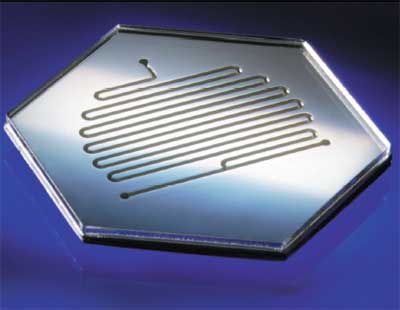German researchers have modified conventional injection moulding techniques to produce small precision metal components — an impossible feat with traditional plastic injection moulding.
Injection moulding intricate parts in a number of plastic materials is a well-known and inexpensive form of production. However, for some engineering applications, thermo-plastic materials have inadequate mechanical properties. By incorporating a high-volume fraction of metal powder into a mix it is possible to create a plastic-bonded metal with highly desirable properties.
Now researchers at the Fraunhofer Institute for Manufacturing and Advanced Materials (IFAM) in Bremen, have modified this variation to produce micromechanical components. The process works by mixing the metal powder with a binding agent; the paste-like mass is then injection moulded. In the second stage the component is gradually heated in an inert gas atmosphere, where the binding agent decomposes and escapes.
Then, at temperatures well below boiling point, the powder particles of metal sinter together and the component becomes compact, attaining up to 99 per cent of its maximum density. This makes the mechanical properties generally superior to those of traditional processes.
Dr Astrid Rota of IFAM’s micro engineering department explained that the low viscosity of the powder introduced is important to ensure the structure can be remoulded from the mould. ‘We can create finer structures in the injection moulding process of metals and micro-metals with the help of the injection moulding,’ she said.
‘We can make all kinds of small metal parts. The application area is not only in micro-process technology, but can also be used in the automotive industry or consumer goods sector,’ said Rota. ‘One general example is in micro- drives or micro-motors, but we can also produce parts for household devices where small parts and complicated structures are used and we can manufacture them cost effectively.'

This mini-reactor is made of injection-moulded stainless steel.
One such device is a stainless steel mini-reactor, which was produced and then coated with a titanium dioxide layer. Working with the Institute of Environmental Process Engineering (IUV) at the University of Bremen and Q-Bioanalytic in Bremerhaven, the Fraunhofer team has proved that such mini-reactors show the effect of deactivating germs when radiated with UV light. So it is hoped that the technology made possible through the new metal injection technique could be applied to water purification.
Rota explained that metals can provide benefits such as high thermal and electrical conductivity, chemical and thermal resistance as well as component recyclability.
But their hardness and high melting points have so far limited the extent to which they could be processed for this purpose, hence injection moulding was not an option, and consequently every part had to be manually machined.
IFAM’s modified technique should eliminate this and allow for far more efficient production.
Building on their current research in injection moulding, Rota said that in the future they would like to work with alternative materials.
‘We want to work on more difficult materials like titanium and catalytic materials for micro-reactive technology for future development,’ she said.




Nanogenerator consumes CO2 to generate electricity
Whoopee, they've solved how to keep a light on but not a lot else.